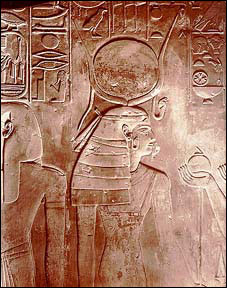
Silver gelatin on
glass 23.5 x 29.5 cm Epigraphic Survey, Oriental Institute, University of Chicago |
Tomb of
Sety I.
The tomb of Sety I lies in the Valley of the Kings. In this sculpted detail, the king offers wine to the goddess Hathor. Often called a goddess of love, Hathor can also represent seductive danger. This scene suggests the worship of the eye-lioness-uraeus forms of the "distant goddess," whose myth is perhaps best attested by the "Story of the Departure of Hathor-Tefnut out of Nubia." Known since the New Kingdom (c. 1560-1085 B.C.), the story tells of the angered eye of the sun, described as the daughter of Ra, a violent goddess in lion form (Tefnut). Retreating into Nubia, she is recalled by Ra, and after she is enticed back to Egypt, she becomes once more the benevolent and happy Hathor. Nonetheless, she requires constant attention, in the form of wine, music, dance, and offerings of desert game, lest she become angry and leave Egypt again. |
| 1 2 3 » 4 : Tomb of Sety I 5 6 7 8 9 10 |